Web accessibility guidelines are recommendations aimed at making web content accessible to all users, particularly those with disabilities. The most recognized guidelines are the Web Content Accessibility Guidelines (WCAG), established by the World Wide Web Consortium (W3C), which outline specific criteria for web accessibility. The article discusses the importance of compliance with these guidelines, highlighting the benefits of improved user experience and increased audience reach. It also covers various tools for ensuring accessibility, such as screen readers and accessibility checkers, as well as strategies organizations can implement to maintain compliance, including accessibility audits and staff training.

What are web accessibility guidelines?
Web accessibility guidelines are a set of recommendations designed to make web content accessible to all users, including those with disabilities. These guidelines aim to ensure that websites are usable by people with various impairments, such as visual, auditory, or cognitive disabilities. The most widely recognized set of guidelines is the Web Content Accessibility Guidelines (WCAG), developed by the World Wide Web Consortium (W3C). WCAG outlines specific criteria that web content must meet to be considered accessible. Compliance with these guidelines can enhance the user experience for all individuals. Studies show that adhering to accessibility standards can improve website usability and increase audience reach.
Why are web accessibility guidelines important?
Web accessibility guidelines are important because they ensure that all users, including those with disabilities, can access and use web content. These guidelines promote inclusivity and equal access to information. According to the World Health Organization, over 1 billion people live with some form of disability. Without accessibility guidelines, many of these individuals face barriers when navigating online environments. Implementing these guidelines can improve user experience and satisfaction. Additionally, compliance with accessibility standards, such as WCAG, can reduce legal risks for organizations. Adhering to these guidelines also enhances search engine optimization, making content more discoverable. Overall, web accessibility guidelines are essential for fostering an inclusive digital landscape.
How do web accessibility guidelines impact users with disabilities?
Web accessibility guidelines significantly improve the online experience for users with disabilities. These guidelines ensure that websites are designed to be usable by individuals with various disabilities, including visual, auditory, and cognitive impairments. By following these guidelines, developers create content that is perceivable, operable, understandable, and robust. For instance, guidelines promote the use of alternative text for images, enabling screen readers to convey information to visually impaired users. Additionally, they encourage keyboard navigation, allowing users with mobility impairments to access content without a mouse. Research shows that implementing these guidelines can increase website usability by up to 50% for users with disabilities. This enhanced accessibility fosters greater inclusion and equal access to information and services online.
What legal implications arise from non-compliance with web accessibility guidelines?
Non-compliance with web accessibility guidelines can lead to legal repercussions. Organizations may face lawsuits under the Americans with Disabilities Act (ADA). The ADA mandates accessible services for individuals with disabilities. Failure to comply can result in costly settlements or judgments. For example, a notable case involved Domino’s Pizza, where a federal court ruled in favor of a visually impaired customer. This decision highlighted the necessity for accessible websites. Additionally, non-compliance can damage a brand’s reputation and customer trust. Regulatory bodies may also impose fines for violations. Thus, adhering to web accessibility guidelines is crucial to avoid legal issues.
What principles underpin web accessibility guidelines?
The principles that underpin web accessibility guidelines are Perceivable, Operable, Understandable, and Robust. These principles are part of the Web Content Accessibility Guidelines (WCAG).
Perceivable means that information and user interface components must be presented in ways that users can perceive. For example, text alternatives must be provided for non-text content. Operable indicates that users must be able to operate interface components and navigate the content. This includes ensuring that all functionality is available from a keyboard.
Understandable refers to the clarity of information and the operation of the user interface. Content must be readable and predictable. Finally, Robust means that content must be robust enough to be interpreted reliably by various user agents, including assistive technologies.
These principles ensure that web content is accessible to a wide range of users, including those with disabilities. The WCAG guidelines are widely recognized and adopted globally to improve web accessibility.
What is the POUR model in web accessibility?
The POUR model in web accessibility refers to four key principles: Perceivable, Operable, Understandable, and Robust. These principles ensure that web content is accessible to all users, including those with disabilities. Perceivable means that information must be presented in ways that users can perceive, such as providing text alternatives for non-text content. Operable indicates that users must be able to navigate and interact with the interface effectively. Understandable emphasizes that information and operation must be clear and consistent. Robust signifies that content must be compatible with current and future user agents, including assistive technologies. These principles are foundational to creating accessible web experiences as outlined in the Web Content Accessibility Guidelines (WCAG).
How do these principles enhance user experience?
Web accessibility principles enhance user experience by ensuring that digital content is usable by everyone, including people with disabilities. These principles promote inclusivity, allowing users to navigate, understand, and interact with websites effectively. For instance, providing text alternatives for images helps visually impaired users access content. Implementing keyboard navigability ensures that users with motor impairments can navigate sites without a mouse. According to the World Health Organization, over 1 billion people experience some form of disability, highlighting the importance of accessibility. Enhanced user experience leads to increased engagement and satisfaction, benefiting businesses and organizations.
What are the key components of web accessibility guidelines?
The key components of web accessibility guidelines include perceivability, operability, understandability, and robustness. Perceivability ensures that information is presented in ways that users can perceive. This includes providing text alternatives for non-text content. Operability requires that users can navigate and interact with the interface. This includes keyboard accessibility and sufficient time to read content. Understandability means that information and operation of the user interface must be clear and easy to understand. This includes using simple language and consistent navigation. Robustness ensures that content can be reliably interpreted by various user agents, including assistive technologies. These components align with the Web Content Accessibility Guidelines (WCAG) established by the World Wide Web Consortium (W3C).
What standards and regulations govern web accessibility?
The primary standards and regulations governing web accessibility include the Web Content Accessibility Guidelines (WCAG), Section 508 of the Rehabilitation Act, and the Americans with Disabilities Act (ADA). WCAG provides a comprehensive framework for making web content more accessible to individuals with disabilities. It outlines specific criteria for accessibility, categorized into four principles: Perceivable, Operable, Understandable, and Robust. Section 508 mandates federal agencies to ensure their electronic and information technology is accessible to people with disabilities. The ADA prohibits discrimination based on disability and has been interpreted to include digital accessibility. Together, these standards and regulations create a legal and ethical framework for web accessibility.
How do these components vary across different regions?
Web accessibility components vary significantly across different regions. These variations are influenced by local laws, cultural attitudes, and technological infrastructure. For example, the United States follows the Americans with Disabilities Act (ADA), which mandates specific accessibility standards. In contrast, the European Union enforces the Web Accessibility Directive, requiring member states to implement uniform accessibility guidelines. Additionally, countries like Australia have their own standards, such as the Disability Discrimination Act, which emphasizes accessibility in public services. Cultural factors also play a role; some regions prioritize accessibility more than others based on societal values. Furthermore, technological availability can affect how accessibility tools are implemented and utilized. These regional differences highlight the importance of understanding local contexts in web accessibility practices.

What tools are available for ensuring web accessibility?
Tools available for ensuring web accessibility include screen readers, accessibility checkers, and keyboard navigation aids. Screen readers convert text to speech, enabling visually impaired users to access content. Popular screen readers include JAWS, NVDA, and VoiceOver. Accessibility checkers, such as WAVE and Axe, evaluate web pages for compliance with standards like WCAG. These tools identify issues like missing alt text and color contrast problems. Keyboard navigation aids help users who cannot use a mouse. Examples include Skip Links and ARIA landmarks. These tools collectively enhance the usability of websites for people with disabilities.
How do automated tools assist in web accessibility compliance?
Automated tools assist in web accessibility compliance by identifying accessibility issues in digital content. These tools scan websites for compliance with standards like WCAG (Web Content Accessibility Guidelines). They check for missing alt text, color contrast issues, and keyboard navigation problems. Automated tools provide reports detailing specific violations and suggestions for remediation. They enable developers to address issues before manual testing, saving time and resources. Studies show that using automated tools can significantly enhance compliance rates. For instance, a 2021 report indicated that websites using such tools improved accessibility scores by an average of 30%.
What are the limitations of automated accessibility testing tools?
Automated accessibility testing tools have several limitations. They often miss context-specific issues that require human judgment. For example, they may not accurately evaluate the usability of content for individuals with disabilities. These tools typically focus on identifying technical errors rather than assessing overall user experience. Furthermore, they can struggle with dynamic content and complex layouts. Studies show that relying solely on automated tools can lead to a false sense of compliance. A 2020 report by the W3C indicated that automated tools can only detect about 20-30% of accessibility issues. Therefore, manual testing is essential for comprehensive accessibility evaluation.
Which tools are considered the best for web accessibility audits?
The best tools for web accessibility audits include WAVE, Axe, and Lighthouse. WAVE provides visual feedback about the accessibility of web content. Axe offers automated testing and detailed reports on accessibility issues. Lighthouse is integrated into Chrome DevTools and evaluates performance, accessibility, and SEO. These tools help identify and fix accessibility issues effectively. Their widespread use in the industry supports their credibility.
What manual techniques can enhance web accessibility?
Manual techniques that can enhance web accessibility include using semantic HTML, ensuring sufficient color contrast, and providing alt text for images. Semantic HTML structures content meaningfully, aiding screen readers in navigation. Sufficient color contrast improves readability for visually impaired users. Alt text describes images, giving context to those who cannot see them. Additionally, using headings correctly helps organize content for better comprehension. Implementing keyboard navigation allows users to access all features without a mouse. Providing clear link text enhances understanding of the content’s purpose. Testing with real users can identify barriers and improve overall accessibility. These techniques align with the Web Content Accessibility Guidelines (WCAG) standards.
How can user testing improve web accessibility?
User testing can significantly improve web accessibility by identifying barriers that users with disabilities face. It involves real users interacting with a website to provide feedback. This feedback highlights specific issues that automated tools may miss. For instance, users may struggle with navigation, color contrast, or screen reader compatibility. Testing with diverse users ensures that various disabilities are considered. Research shows that websites tested with users are more likely to meet accessibility standards. According to the World Health Organization, over 1 billion people experience some form of disability. Therefore, user testing is essential for creating inclusive web experiences.
What role does expert review play in ensuring accessibility?
Expert review plays a critical role in ensuring accessibility. Experts evaluate digital content against established accessibility standards. Their analysis identifies barriers that may hinder users with disabilities. This process enhances the usability of websites and applications. Experts provide actionable recommendations for improvement. Research shows that expert reviews lead to significant compliance with guidelines like WCAG. By addressing specific accessibility issues, expert reviews enhance user experience. This ultimately fosters inclusivity in digital environments.

What strategies can organizations adopt for compliance with web accessibility guidelines?
Organizations can adopt several strategies for compliance with web accessibility guidelines. Implementing an accessibility audit is essential. This audit evaluates existing digital content against established standards like WCAG. Training staff on accessibility best practices ensures ongoing compliance. Regular updates to content should incorporate accessibility features. Engaging users with disabilities for feedback improves usability. Utilizing automated accessibility testing tools can streamline compliance efforts. Establishing a dedicated accessibility team can oversee ongoing initiatives. Documenting compliance processes helps maintain accountability and track progress.
How should organizations approach the implementation of web accessibility guidelines?
Organizations should approach the implementation of web accessibility guidelines by adopting a structured framework. This framework should include assessing current accessibility standards and identifying areas for improvement. Organizations must engage stakeholders, including users with disabilities, to gather insights. Training staff on accessibility best practices is essential for fostering an inclusive culture. Regular audits of web content and design should be conducted to ensure compliance with guidelines. Utilizing automated accessibility tools can aid in identifying issues efficiently. Additionally, organizations should establish a continuous feedback loop for ongoing improvement. Studies show that accessible websites enhance user experience and increase reach, making this approach beneficial for both users and organizations.
What steps are involved in creating an accessibility policy?
Creating an accessibility policy involves several key steps. First, assess the current accessibility status of your website or service. This includes identifying barriers that users with disabilities may face. Next, engage stakeholders, including people with disabilities, to gather insights and feedback. Then, establish clear objectives and goals for the accessibility policy. It is important to define the scope of the policy, including which areas it will cover. After that, outline specific guidelines and procedures to achieve accessibility goals. Training staff on these guidelines is crucial for implementation. Finally, review and update the policy regularly to ensure ongoing compliance and improvement. These steps align with best practices in web accessibility, promoting inclusivity for all users.
How can training staff improve compliance efforts?
Training staff improves compliance efforts by enhancing their understanding of regulations and best practices. Educated employees are more likely to recognize compliance issues. They can effectively implement accessibility guidelines in their work. Training also fosters a culture of accountability. When staff are aware of the importance of compliance, they are more motivated to adhere to standards. Research shows that organizations with comprehensive training programs see a 30% increase in compliance rates. This correlation highlights the effectiveness of training in promoting adherence to web accessibility guidelines.
What common challenges do organizations face in achieving web accessibility?
Organizations face several common challenges in achieving web accessibility. One major challenge is a lack of awareness among stakeholders about accessibility requirements. Many organizations do not understand the legal implications of failing to comply with accessibility standards. Limited resources, such as budget and personnel, also hinder accessibility efforts. Some organizations struggle with outdated technology that does not support accessible design. Another challenge is the complexity of implementing accessibility features across diverse platforms. Additionally, there can be resistance to change within the organization, affecting commitment to accessibility initiatives. Lastly, insufficient training for staff on accessibility best practices can lead to ongoing issues. These challenges collectively impede the effective implementation of web accessibility.
How can organizations overcome budget constraints for accessibility initiatives?
Organizations can overcome budget constraints for accessibility initiatives by prioritizing cost-effective solutions. They can leverage free or low-cost accessibility tools and resources available online. Collaborating with non-profit organizations or universities can provide additional expertise and support. Implementing accessibility in phases allows organizations to spread costs over time. Seeking grants or funding specifically for accessibility projects can also alleviate financial pressure. Training existing staff on accessibility best practices reduces the need for external consultants. Additionally, engaging users with disabilities in the design process can lead to more effective and targeted solutions. These strategies enable organizations to enhance accessibility without significant financial burdens.
What strategies can be employed to prioritize accessibility in web development?
Implementing semantic HTML is essential for prioritizing accessibility in web development. Semantic HTML provides meaning to web content, allowing assistive technologies to interpret it correctly. Utilizing ARIA (Accessible Rich Internet Applications) roles enhances accessibility for dynamic content. Ensuring keyboard navigability allows users with mobility impairments to access all features. Providing text alternatives for non-text content, like images, ensures everyone understands the information. Regular accessibility testing with tools like WAVE or Axe identifies barriers in web design. Following WCAG (Web Content Accessibility Guidelines) standards helps maintain compliance and improve usability. Training development teams on accessibility principles fosters a culture of inclusivity in web projects.
What are the best practices for maintaining web accessibility over time?
To maintain web accessibility over time, organizations should establish ongoing evaluation processes. Regular audits of web content ensure compliance with accessibility standards like WCAG. Training staff on accessibility best practices fosters a culture of inclusivity. Updating content regularly helps address evolving accessibility needs. User feedback is crucial for identifying barriers. Implementing accessibility checks in the development process prevents issues from arising. Collaborating with accessibility experts enhances understanding and implementation. Documenting accessibility efforts provides a clear reference for future improvements.
How can regular audits contribute to sustained compliance?
Regular audits contribute to sustained compliance by identifying gaps in adherence to web accessibility standards. These audits systematically evaluate websites against established guidelines such as WCAG. They help organizations recognize areas for improvement and ensure that necessary adjustments are made. Regular audits also foster a culture of accountability within teams. By consistently reviewing accessibility practices, organizations can adapt to evolving standards and technologies. Data from the World Health Organization indicates that over 1 billion people experience some form of disability, highlighting the importance of accessibility. Continuous audits help maintain compliance by ensuring that all users have equitable access to digital content.
What ongoing training resources are available for staff on web accessibility?
Ongoing training resources for staff on web accessibility include online courses, workshops, and webinars. Organizations like the Web Accessibility Initiative (WAI) offer comprehensive training materials. The WAI provides guidelines and tutorials that help staff understand accessibility principles. Additionally, platforms like Coursera and LinkedIn Learning offer courses on web accessibility. These courses often include practical examples and case studies. WebAIM also provides resources and training sessions focused on accessibility best practices. Regular updates and new materials ensure that staff stay informed about evolving accessibility standards.
What practical tips can help improve web accessibility?
Use clear and descriptive headings to enhance navigation. Ensure text is readable by using sufficient contrast between background and font color. Provide alternative text for images to describe content for screen readers. Implement keyboard navigation to allow users to access all features without a mouse. Use simple language and short sentences for better comprehension. Test your website with accessibility tools like WAVE or Axe for compliance. Regularly update content to maintain accessibility standards. Engage users with disabilities for feedback on their experience.
Web accessibility guidelines are a set of recommendations aimed at making web content usable for all users, particularly those with disabilities. The article explores the importance of these guidelines, including the Web Content Accessibility Guidelines (WCAG), and their impact on user experience, legal compliance, and organizational reputation. It details the principles of accessibility, tools for assessment, manual techniques for improvement, and strategies for organizations to ensure compliance. Additionally, it addresses common challenges and solutions related to implementing and maintaining accessibility standards in digital environments.
